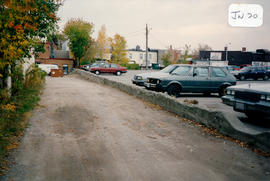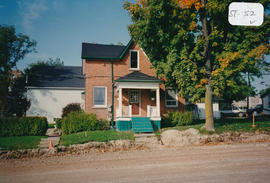This photo (from 1995) shows the remains of the foundation wall of a large, natural-ice skating rink that was once located on the southeast corner of Moore (Lovers’ Lane) and 20 John St. West. The rink, built in 1910, was owned by Thompson Fisher. It was run by Fred McKay and Bethel Sawyer. The ice surface was also used as a curling rink. There were seats for spectators and the ticket office was on the east side. There was a men’s change room and hoses for watering the ice behind the rink (where snow was piled). A lunch room, ladies’ change room, and toilets were on the west side. Overhead was a viewing platform and an organ provided skating music. There was a very large water tank in front for fighting fires and making ice. The rink was well-patronized before the war and skating to band music was also very popular. The entrance fee was 15 or 25 cents. The curling surface was used by quite a number of older people. Horse shows were held here in the summer. The cleanup man was “Sank” Lowe. He wore a white uniform and used a two-wheeled barrel, broom, and shovel for picking up manure. Box lacrosse was also played here. The facility was demolished after the war and the property became a town parking lot. (1, 2)
George JacksonParking Lot
3 Archival description results for Parking Lot
The mid-block building located at 52 Simcoe Road was built post-1900 (1902?) in the Gothic Revival Cottage style. The house, which is larger than other older cottages of a similar style in Bradford, was built on property owned by Charles Adams. Originally, there was a garden to the west and a barn on the lane. Later residents of this house included Joe Brown (a retired farmer from the 10th line) and Jessie, who lived here until he died. Joe was a noted gardener who raised his granddaughter Margaret Turner. Paul Margetiak and his wife and son also lived here at one time. He was a gardener, too, and he built a garage on the property. Len Saint did the cement work and added a closed-in porch. Eventually the property was bought by Gary Swagerman. He lived in the house with his wife and family and eventually had the barn remodelled to become the site of a dry cleaner. The garden was paved and used as a parking lot for the business.
The 1½-storey, three-bay cottage has a rectangular plan, a centre hall, and a symmetrical façade. The medium-pitched, gable roof has a centre gable over the entrance. There are single windows to the primary rooms on each side of the covered entrance porch. A raised, open porch has a hip roof supported on simple, wood columns set directly on the porch base/foundation. The porch has a simple, wood handrail and balusters. A single entrance door is set into a segmented, arched opening. Windows are set into segmented, arched openings with brick voussoirs and concrete lug sills. The windows and door are not original. A second-storey window set halfway into the centre gable is a reference to the Gothic Revival style. Locally-made bricks were placed by Tom Saint on the wood frame construction. According to the 2000 inventory, the house is in good condition. (1, 2, 3)
Although currently being used as a parking lot, there was originally at least one house on this property located at the corner of Drury and Thomas Streets. George, Mell (Mel?), and Davey John had a one-storey, frame stucco house here. Margaret "Maggie" MacDonald was the housekeeper and cook for the family. George was a handyman. He worked for Jack Spencer and Ben Collings fleshing and marsh haying. Mell (Mel?) was a day worker, gardener, handyman, and wood cutter. Davey John was a machinist and bearing lead (?) specialist. He was also a noted storyteller. Behind the house was a woodshed, back porch, chicken run, and chicken house. There was a garden next to the fence of the Queen’s Hotel. There were sheds from the hotel along the west side of the property. Pigs were fed with slops from the hotel. There was a two-storey barn with a loft, horse stables, and car garage facing Elizabeth Street. The house later became the home of Frank Cook, son Norman, and mother (Olive Whiteside). He was a labourer, small truck driver (picking up garbage), and a gravel (grave?) digger. Len and Aida Gardner and family moved into the house years later. They then moved into an apartment when the house was demolished. (1, 2)
George Jackson

